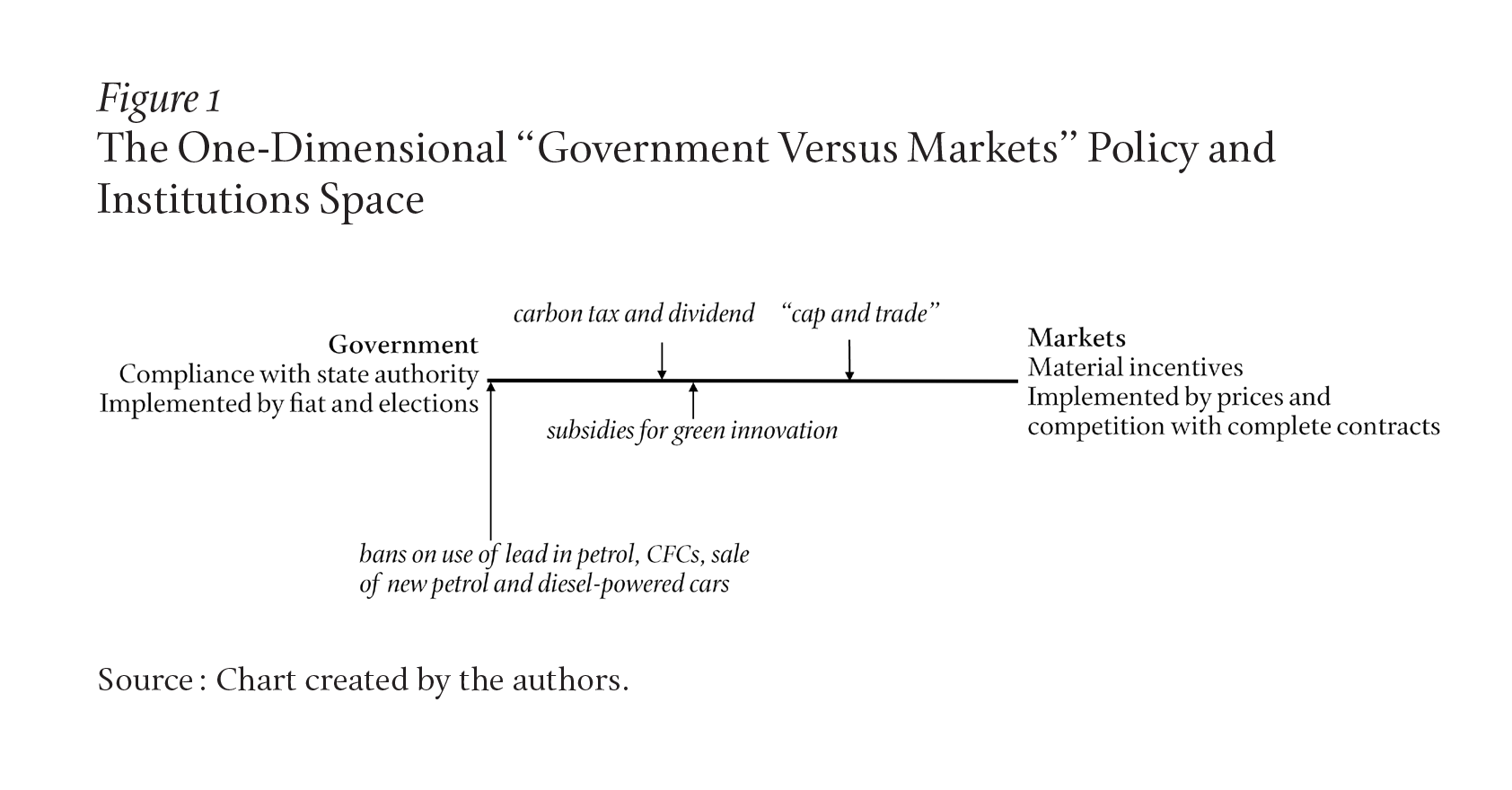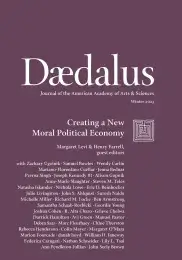Foundations of an Expanded Community of Fate
We develop a representation of markets, states, and civil society as aspects of institutions and policies that might provide the foundations of the expanded community of fate proposed by Margaret Levi and Zachary Ugolnik. What we term our “synergy simplex” provides a language and roadmap for researching and debating the alternatives, a process that the authors (and the moral political economy project they lead) have so fruitfully launched.
The key idea in the sweeping introduction and overview by Margaret Levi and Zachary Ugolnik is that a well-governed society requires that social interactions be structured to sustain an egalitarian, democratic, and solidaristic culture.1 By committing to this perspective in their new moral political economy, they abandon two widely held but sometimes unspoken precepts in policy and institutional design.
The first is that individual preferences are exogenously given rather than sustained, undermined, or modified by people’s life experiences. The second is that the clever design of mechanisms—property rights, legal constraints, incentives, and other rules of the game—is sufficient to ensure good governance, independent of the preferences that motivate people. So good governance does not require good citizens. Taken together, their rejection of these two precepts—exogenous preferences and the idea that good institutions can be designed for what economists term unrestricted preferences—places Levi and Ugolnik in the camp of the political philosophers from Aristotle to Thomas Aquinas, Jean-Jacques Rousseau, and Edmund Burke who recognized the cultivation of civic virtue not only as an indicator of good government but also as its essential foundation.
“Legislators make the citizens good by inculcating habits in them,” Aristotle wrote in the Ethics.2 “It is in this that a good constitution differs from a bad one.” A century earlier, Confucius had provided advice about how rulers should treat their people, and about the pitfalls to be avoided: “Guide them with government orders, regulate them with penalties, and the people will seek to evade the law and be without shame. Guide them with virtue, regulate them with ritual, and they will have a sense of shame and become upright.”3
Confucius provided advice for a ruler. In contrast, Levi has provided an example of a concrete institution that contributed to an expanded community of fate, which is essential to the functioning of the new moral political economy that she and Ugolnik advocate. Drawing on her joint work with John Ahlquist on labor unions of the last century, she writes:
The dockworker and longshore unions on the west coast of the U.S. and in Australia were able to mobilize their members on behalf of distant others who could never reciprocate. They achieved this with governance arrangements that made leaders highly accountable, introduced members to events in the world and then allowed them to come to a determination about whether and how to act. In these unions, leadership successfully delivered what their members rightfully expect of unions: better wages and working conditions, job security and safety, social insurance. But the union also offered education about history and current affairs.4
The values that could support a new expanded community of fate, one concludes from this passage, will be the product not simply of “guidance” by political or cultural leaders but of how we interact with each other.
Levi and Ugolnik have laid out a combined political project and research agenda that challenge the idea that policies can be located along a single dimension as being more left or more right, more pro-state or pro-market. We illustrate this restricted conception of policy choices in Figure 1.5

Compare “carbon tax and dividend” policies, in which the government sets a price on carbon emissions, with “cap and trade” policies, in which the government sets limits on emissions and lets the market determine the price. Each uses a different combination of state capacity and market mechanism to deliver lower carbon emissions (one more neoliberal, closer to the market pole; the other closer to the government pole) .
The limitations of the one-dimensional depiction of the policy-institution space are illustrated by the challenge of environmental sustainability shown in Figure 1. Where do we locate policies that cultivate and mobilize both green values and social pressures from neighbors and friends to alter one’s lifestyle so as to reduce one’s own carbon footprint?
The menu of policies and institutions in Figure 1 is not only ill-equipped to address the conditions for a flourishing expanded community of fate. It also appears anachronistic in light of recent advances in economics, perhaps surprisingly given the prominence of this limited paradigm in discussions about economic policy. Two developments are especially important.
The first, thanks to the “information revolution,” is the recognition that the information available to both governments and private economic actors alike is local and limited. The result is to curtail the ability of either private contract or governmental fiat to address many problems. The consequences go beyond market and state failures, respectively. Limited information is also the reason why many economic interactions take the form not of market exchanges, like the purchase of bread or steel, but instead principal-agent relationships in which one party to the exchange, for example, the employer or the lender, exercises a form of private power over the other, the worker or the borrower.
The second development, due to behavioral economics, is an essential piece of the expanded community of fate idea that Levi and Ugolnik have advanced. It is that people have preferences and ethical commitments regarding others that exceed the amoral and self-interested economic man. Equally important values such as generosity, fairness, and reciprocity appear to be cultivated in environments in which people of necessity work together cooperatively to make their living. This was observed in a set of behavioral experiments played in small-scale societies around the world—farmers, herders, hunters of large game—and in a study of Brazilian fishermen that compared the large and necessarily cooperative crews of ocean fishers with the individual and highly competitive lake fishers.6
The one-dimensional paradigm and its policy levers thus overlook the opportunities for solutions drawing on what Levi and Ugolnik call the social character of people, our intrinsic motivations to help others and to do a good job, our desire to construct a dignified identity, and the power of social norms, such as greener consumption preferences. As a result, a new space opens up for policies and also for new critiques of the status quo.
These social preferences may constitute not only an opportunity for better societal governance missed in the one-dimensional paradigm, but when ignored, a cause of ineffective and even counterproductive policy. There is some evidence, for example, that paying for blood donations reduces the supply (at least among men).7 And during the 2020–2021 COVID-19 pandemic in Germany, “control-averse” citizens enthusiastically supported vaccination if it were to be voluntary but much less so if it was required by the government.8
We propose an alternative two-dimensional space for institutions and policies, shown in Figure 2.
![Figure 2: State, Market, Civil Society Complementarities in a New Paradigm A triangular graph situates the dynamics between three poles. The poles are Government (Compliance with state regulations), Markets (Material incentives), and Civil Society (Reciprocity, altruism, fairness, sustainability, dignity, identity [including in-group]). Among their related institutions & policies are “house-price insurance to reduce risk & promote innovation, unconditional basic income,” “rights for citizens as co-owners of databases held by big tech firms,” & “civil society–led green innovation."](/sites/default/files/media/images/Bowles_Carlin-Figure-2_2.png)
The third pole in Figure 2 is civil society, and any point in the interior of the triangle represents a particular configuration of policies or institutions that combine motivation and implementation mechanisms from all three poles working together. Thus, entries represent organizations or policies with differing combinations of rules of the game and motivations characterized by the three vertices.
We call it the synergy simplex because Levi and Ugolnik do not pose the question as governments versus markets or state versus civil society. Instead, well-designed organizations and rules of the game allow its vertices—governments, markets, and civil society—to work in complementary ways rather than as substitutes. So, for example, they see both state coercion and social norms as essential; neither works without the other.
Dismissed by some as a fringe concern, the impact of values’ changes can be substantial. A recent empirical study of “green” and “dirty” patents in the automobile manufacturing sector around the world found that a greening of values (of a magnitude observed over the past two decades) along with increased competition would account for a greening of innovation of the same magnitude as would have resulted from a (politically explosive) 40 percent increase in fuel prices.9
Consistent with a new moral political economy, the simplex also provides a way of conceptualizing the sources of economic growth, not in material output but in the subjective well-being of people that Levi and Ugolnik stress. A revival of economic dynamism is essential for addressing the climate and biodiversity crises. And, modeled by the new Schumpeterian growth theory, that revival will depend on mobilizing the complementary strengths of creative destruction among capitalist firms (markets) motivated in part by green social norms (civil society), on the ability of the state to direct innovation and enforce competition and regulation, and on new policies to democratize access to innovation.10
Our synergy simplex does not show how an expanded community of fate might be created. But it does provide a language and roadmap for researching and debating the alternatives, a process that Levi and Ugolnik (and the moral political economy project they lead) have so fruitfully launched.
authors’ note
For support of our research, we thank the Behavioral Sciences Program of the Santa Fe Institute and the James M. and Cathleen D. Stone Centre on Wealth Concentration, Inequality, and the Economy at University College London.
